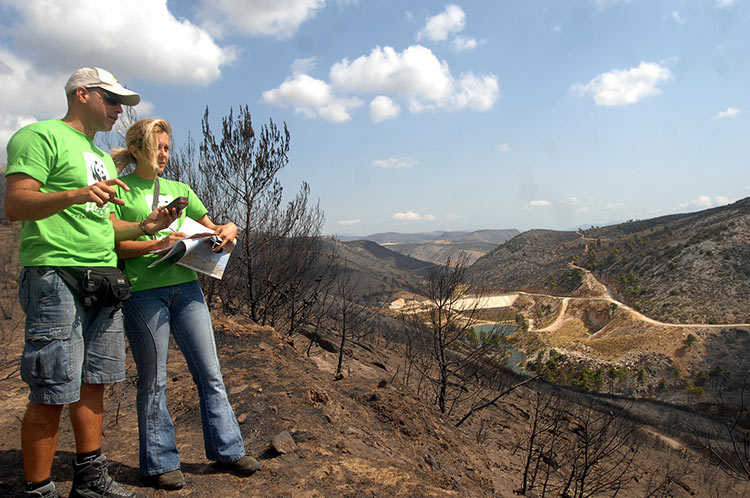WWF takes action after every large forest fire. We are not content with counting our losses. Therefore, we work on the ground in fire-stricken areas to promptly record the extent of burnt areas and to assess the ecological consequences. We proceed by publicizing detailed reports of our findings and - most importantly - by presenting concrete proposals for recovery to the proper authorities. We have completed a total of 12 reports (in Greek):
- Parnitha | 2007
- The Peloponnese | 2007
- Euboea | 2007
- Rhodes | 2008
- Northeastern Attica | 2009
- Zakynthos | 2009
- Karystos | 2009
- Elikon and Cithaeron, Boeotia | 2009
- Preveli Palm Forest, Crete | 2010
- Central Evros | 2011
- Fire in Southeastern Attica | 2012
- Chios | 2012
Where Our Actions Make a Difference
In many of the surveyed areas, following our collaboration with local forest services, the measures that we proposed for the recovery of the natural environment were adopted. In the protected area of Lake Kaiafa, for instance, the cutting and removal of burnt trees was suspended because it was impeding the natural regeneration process and degrading the general ecosystem. In Rhodes and Central Evros, concrete measures for conserving burnt trees were adopted to foster the natural regeneration of the different species of pine, protect and enrich the soil, and enhance the overall function of the biotope as a refuge for forest fauna. In Crete, the palm forest was ring-fenced to impede visitor entry until the ecosystem had recovered. After the recent fire in Chios, concerned citizens took action and have already organized reforestation activities.
Providing Solutions
In cooperation with scientific institutions, we put in 28,886 hours of work in the forests to record and analyze the fire-stricken areas’ ecosystems, focusing on the Peloponnese, aiming to manage and protect natural regeneration and identify areas in need of specific restoration interventions.
The Peloponnese Example
Specifically, we surveyed the condition of the burnt areas in the Peloponnese and in 235 municipal districts in the prefectures of Arcadia, Achaia, Ilia, Messinia and Lakonia, and recorded probable changes in land use in burnt (and unburnt) areas, grazing activity, the progress of vegetation and the risk of ecosystem erosion.
Our work in the Peloponnese resulted in the creation of a detailed database, which helped us arrive at the following important conclusions:
There is visible risk of change in land use in some areas (prefecture of Ilia) mainly due to agricultural expansion at the expense of forested areas.
- Regeneration is satisfactory in most burnt areas, and problems are detected mainly in areas where fire has struck repeatedly (during the last 10–20 years) or in areas with cold resistant conifers (e.g. firs), such as Mt. Klokos, the Taygettus mountain range and others.
- There are vegetation degradation issues in mountain areas (mostly in Arcadia, Messinia and the semi-mountainous area of Ilia) due to overgrazing.
- Egialia and certain areas of Ilia are facing the most significant problems of erosion.
- We recorded and monitored the progress of flora and fauna in fire-stricken areas in order to draw conclusions about the necessity of preserving unburnt patches and adopting specific measures for their protection.

© WWF Greece
In Ilia, after counting 19,634 pine sprouts in an 8,400 square meter fire-stricken area, we identified the areas that were already facing or were likely to face regeneration problems. A detailed account of the applied methodology and the areas where we identified the need for reforestation is given in the report Prediction of Post-Fire Regeneration in Burnt Allepo Pine (Pinus halepensis) Forests at Ilia Prefecture (in Greek).
Furthermore, we made efforts to contribute to the accurate documentation of grazing issues in the Peloponnese and to formulate adequate measures for managing animal husbandry pressure in the burnt areas.
Recognizing that forest animals are the direct victims of wildfires, we monitored 603 red deer in Parnitha and 603 jackals in the Peloponnese and Chalkidiki, and put forward proposals concerning conservation and management measures. For more information, visit the Threatened Species section.
Finally, we participated in the study on the restoration of burnt areas in the Peloponnese (in Greek) that was carried out by the Agricultural University of Athens on behalf of the Ministry of Rural Development and Food, providing specialized knowledge on issues such as the restoration of protected areas.
Part of our work was carried out in cooperation with scientific institutions, including the following:
- Aristotle University of Thessaloniki: Laboratory of Forest Management and Remote Sensing, School of Forestry and Natural Environment
- Aristotle University of Thessaloniki: Laboratory of Rangeland Ecology, School of Forestry and Natural Environment
- National Agricultural Research Foundation: Institute of Mediterranean Forest Ecosystems and Forest Products Technology
- National and Kapodistrian University of Athens: Department of Ecology, Faculty of Biology
- University of Patras: Department of Animal Biology, Faculty of Biology
- National Observatory of Athens: Institute of Environmental Research and Sustainable Development
- Technological Educational Institute of Ionian Islands (Zakynthos): Department of Environmental Technology and Ecology
- Agricultural University of Athens
- Callisto Environmental Organization
Share this



